
Download the entire report as a PDF file. If you don't have the Acrobat Reader click here to download and install on your computer.

Summary
Elemental Chlorine-Free (ECF) pulp, bleached with chlorine dioxide, continues to dominate the world bleached chemical pulp market. By the end of 1998, ECF production will be 42 million tonnes, totaling 54% of the world market.
Market data shows an ever widening gap between ECF and TCF (Totally Chlorine-Free) production. ECF continues to grow, with an additional 4 million tonnes entering the market in 1998. In contrast, the TCF market remains stagnant at 6% of the world market. As in 1997, no production increase is expected for TCF in 1998.
As the international scientific community increasingly recognizes and documents ECFs proven pollution prevention record and overall environmental integrity and superior product quality, end-users are supporting its growth.
Market Response
ECFs steady growth is an acknowledgment of its environmental performance, cost-competitiveness, and high quality. Support for ECF was further strengthened in April of 1998, when the United States Environmental Protection Agency (EPA) released the Cluster Rule for the pulp and paper industry. The Cluster Rule is based in part on ECF as the Best Available Technology (BAT) for bleached paper grade kraft and soda mills [1]. "ECF continues to remain strong in the world market, expanding its market share by 10%." Seeking high quality, cost-competitive pulps with a superior environmental track record, consumers have driven the growth of ECF production. In response, mills facing modernization in Sweden, South America, and Germany are choosing ECF-based production to meet the market demand, produce high quality, and to minimize operating costs.
For example a Swedish liquid packaging board producer that recently modernized its bleach plant reported [2]:
"The research carried out showed that no TCF sequence could fulfill the brightness goal without impairing the pulp quality, when compared to ECF bleaching sequences such as OD(EOP)DED and O(OP)DQ(PO)."
In another case, a Brazilian producer recently modernized one of their fiber lines for production of fully bleached market eucalyptus pulp. The mill chose an ECF sequence that also had the capability to produce TCF pulp [3]:
"When and as needed to attend to the decreasing TCF market demand."
More importantly, a TCF sulfite mill in Germany is being converted to an ECF kraft mill with the capability to produce TCF [4]. While a small market for TCF pulp still exists in Europe, demand in the rest of the world continues to spur the growth of ECF.
World Bleached Chemical Pulp Production Profile In 1998, ECF will command the highest worldwide market share at 54%, totaling 42 million tonnes. This marks a 10% production increase from 1997. ECF market share continues to grow in most pulp producing regions.
"ECF remains the process of choice in most pulp producing regions, commanding 54% of the world market."
World BCP Production: 1990 - 1998
North AmericaIn North America, ECF pulp production will increase by 12% in 1998, representing 63% of the market. In contrast, TCF pulp production is expected to remain stagnant in 1998.
Separately, in 1998, Canadian ECF pulp production will grow by 4% to 9.1 million tonnes, holding more than 76% of the market, while TCF production declined to less than 10,000 tonnes.
In the United States, ECF continues to grow rapidly, with another 2.3 million tonnes entering the market in 1998. ECF production grew by 17% to more than 15 million tonnes, or 57% of the U.S. bleached chemical pulp production market. For the first time in the U.S., the ECF bleaching process is used more than any other bleaching process.
North American BCP Production: 1990 - 1998
ScandinaviaIn Scandinavia, ECF demand remains strong, accounting for approximately 75% of bleached chemical pulp production -- triple that of TCF.
Japan
Japan produces approximately 8 million tonnes of bleached chemical pulp. No TCF is produced in Japan and while ECF production is low, it is beginning to grow. A producer recently announced the start-up of Japans first large scale ECF production line with capacity of 400,000 tonnes per year [5].
Scandinavian BCP Production: 1990 - 1998Environmental Performance And Eco-System Response
Numerous studies have examined the relative environmental quality of waste waters from mills operating with the ECF bleaching process. An international science advisory panel reviewed scientific progress since 1993 and reached the following conclusion [6]:
"The risk assessment for chlorinated substances reconfirms the earlier conclusions that chlorinated substances discharged following secondary treatment present a negligible risk to aquatic ecosystems."
In terms of policy decisions, this conclusion has been recognized in the European community. The following statement was recorded in the minutes of the Technical Working Group for drafting Best Available Technology (BAT) reference documents under the European Community (EC) Integrated Pollution Prevention and Control (IPPC) Directive [7]:"General acceptance that the use of molecular chlorine is now abandoned for environmental reasons. At least a high degree of chlorine dioxide substitution might be expected with ECF or TCF as preferred options. It has not been proven that there is any environmental benefit in universally requiring TCF."
The pulp and paper industry continues to strive to prevent pollution with technologies that are cost effective and produce a high quality product. ECF is an excellent example of bringing these qualities together and its popularity and growth is matched by the continuous recovery of aquatic eco-systems.
The waterbodies of the United States continue to showcase broad eco-system recovery. Since 1990, 13 states have lifted a total of 20 fish consumption advisories for dioxin downstream of pulp mills, representing a decline of more than 50%. Two additional advisories were lifted in 1998 [8].
Lifting of Fish Consumption Advisories for Dioxin Downstream of Pulp Mills Looking Ahead
Building on its previous success, the industry is advancing its pollution prevention goal one step further, by exploring the concept of a minimum-impact mill.
"The industrys environmental progress over the last 30 years, while maintaining economic viability, bodes wellfor the next 30 years and provides confidence that the minimum-impact mill of the future will be realized [9]."
The vision of the minimum-impact mill is attracting increasing attention from industry experts, governing bodies, and interest groups and is viewed as the industrys next step. Minimum-impact mills will reduce water use, minimize the use of raw materials, maximize energy production and produce a high quality product [9].
As research progresses, preliminary conclusions and operating experience show that ECF is compatible with -- and may become the cornerstone of -- the minimum-impact mill of the future.
Sources
The Alliance for Environmental Technology, "Trends in World Bleached Chemical Pulp Production: 1990-1997," March 1997.1998 AET International Survey
Pryke, D.C. and Reeve, D.W., "Substitution of Chlorine Dioxide for Chlorine in Canadian Bleached Chemical Pulp Mills." Bleaching Committee, Technical Section, CPPA. April 1996.
References
1. Federal Register, Vol. 63, No. 72. April 15, 1998.2. Savolainen, R., Norberg, K. and Lindberg, H. "A Modern ECF Bleaching Concept: Experience and ECO Mill Perspectives at Stora Skoghall." Proceedings, 1998 International Pulp Bleaching Conference, Helsinki, Finland. June 1-4, 1998.
3. Mokfienski, A., Demuner, B.J., Manhacs, G.F., Cesena, P.H.Y., de Araujo, G. and Neves, R. "Steps Toward Selecting a Bleaching Sequence in Aracruz Modernization Project." Proceedings, 1998 International Pulp Bleaching Conference, Helsinki, Finland. June 1-4, 1998.
4. Mercer International Inc. "Mercer International Inc. Announces Approval for Conversion Project." Press Release, March 18, 1998.
5. Hokuetsu Paper Mills, Press Release, July 1998.
6. Bright, D. A., K., Hodson, P.V., Lehtinen, K-J., McKague, B., Rogers, J. and Solomon, K.."Evaluation of Ecological Risks Associated with the Use of Chlorine Dioxide for the Bleaching of Pulp: Scientific Progress Since 1993". Proceedings, 1998 International Pulp Bleaching Conference, Helsinki, Finland. June 1-4, 1998.
7. Environmental Monitor. Harriman Chemsult, February 1998. p. 16.
8. Alliance for Environmental Technology, "Eco-System Recovery: Liftings of Fish Consumption Advisories for Dioxin Downstream of U.S. Pulp Mills," October 1998.
9. Axegård P., Carey, J., Folke, J., Gleadow, P., Gullichsen, J., Pryke, D.C., Reeve, D.W., Swan, B. and Uloth, V., Minimum-Impact Mills: Issues and Challenges, In press, proceedings 1997 TAPPI International Environmental Conference, May, 1997.
Appendix (ALL DATA IN MILLIONS ON TONNES*)
World ECF TCF Other 1990 3.5 0.1 62.7 1991 8.2 0.4 58.2 1992 15.0 1.2 51.8 1993 20.0 2.6 46.9 1994 25.8 4.1 40.8 1995 31.2 4.7 36.8 1996 34.0 4.5 35.0 1997 38.0 5.1 34.4 1998 42.2 4.8 31.5
United States ECF TCF Other 1990 0.5 0.0 26.8 1991 1.6 0.01 25.6 1992 2.8 0.01 24.4 1993 4.0 0.2 23.0 1994 6.0 0.2 21.0 1995 9.1 0.3 17.9 1996 10.4 0.2 16.6 1997 13.3 0.2 13.8 1998 15.5 0.2 11.5
Scandinavia ECF TCF Other 1990 2.3 0.1 6.5 1991 4.0 0.3 4.7 1992 6.6 0.6 2.0 1993 7.7 1.3 1.1 1994 8.5 2.2 0.0 1995 8.3 2.8 0.0 1996 7.6 2.6 0.0 1997 8.3 3.1 0.0 1998 7.9 2.9 0.0
Canada ECF TCF Other 1990 0.7 0.0 10.3 1991 1.3 0.0 9.7 1992 2.6 0.04 8.4 1993 3.9 0.05 7.0 1994 5.5 0.05 7.0 1995 7.3 0.04 4.2 1996 8.1 0.04 4.0 1997 8.7 0.04 3.4 1998 9.1 0.01 2.8
REST OF WORLD (Includes Western Europe, Chile, Brazil, South East Asia, Africa, Australia, New Zealand, and Japan) ECF TCF Other 1990 0.0 0.0 19.2 1991 1.4 0.1 18.2 1992 2.9 0.6 17.0 1993 4.4 1.1 15.7 1994 5.8 1.6 14.3 1995 6.4 1.6 14.7 1996 7.9 1.7 14.4 1997 7.7 1.8 17.2 1998 9.7 1.7 17.2
The Alliance for Environmental Technology (AET) is an international association of chemical manufacturers and forest products companies dedicated to improving the environmental performance of the pulp and paper industry. AET was created to establish a clearinghouse of educational and technical resources relating to chlorine dioxide and its use in chemical pulp bleaching.
For more information, call AET at 1-(800)-999-PULP.



